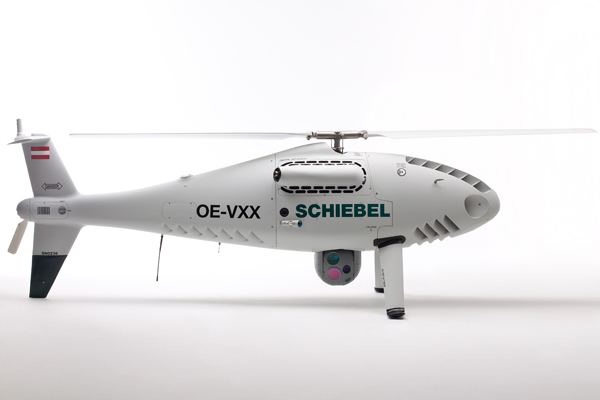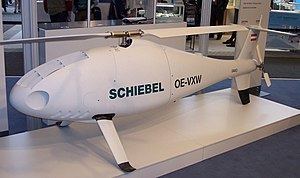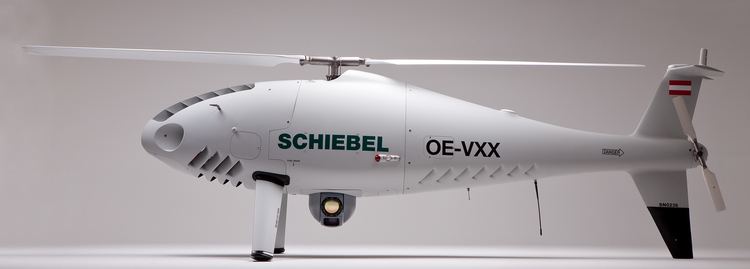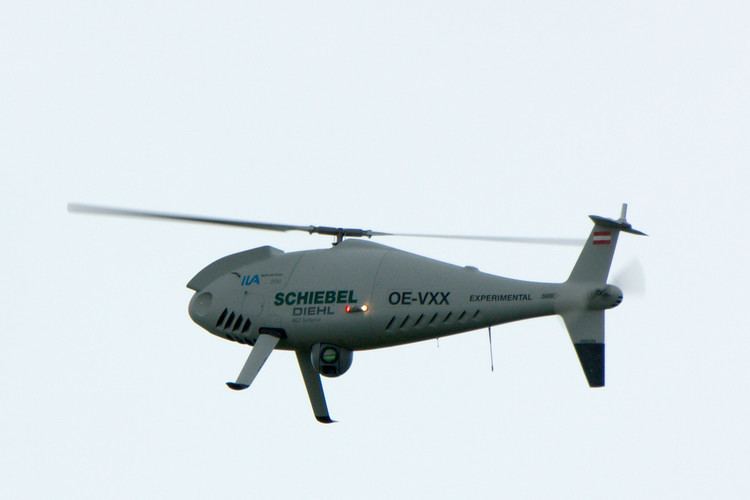Top speed 222 km/h Length 3.11 m Weight 110 kg | Range 180 km Wingspan 3.4 m Cruise speed 185 km/h | |
 | ||
The Schiebel Camcopter S-100 is an Austrian unmanned aerial vehicle (UAV) using a rotorcraft design.
Contents
Design and development

Produced by the Austrian company Schiebel, it was developed from 2003 to 2005. With a maximum take-off weight (MTOW) of 200 kilograms (440 lb), its endurance is 6 hours. It has a maximum speed of 220 kilometres per hour (140 mph) and a ceiling of 5,500 metres (18,000 ft). It is powered by a 55 horsepower (41 kW) Diamond engine and can carry various payloads, such as electro-optics and infrared sensors.

On 12 March 2012 Schiebel announced that it successfully tested a company-developed heavy-fuel engine interchangeable with the standard Diamond engine. This heavy-fuel engine allows for the use of JP-5, Jet A-1 or JP-8 jet fuels. These fuels, which are standard on marine vessels, are safer to store and handle than gasoline.

On 7 February 2013, Schiebel flight tested a Thales Group I-Master surveillance radar system on the Camcopter at its Wiener Neustadt, Austria, facility. The I-Master system, weighing 30 kg (66 lb), provides ground moving target indication and synthetic aperture radar operations.
International customers

The launch customer for the S-100 was the UAE Army, which ordered 40 aircraft with an option for 40 more. The aircraft was ordered by three more undisclosed nations, with total orders reaching 200.

The Camcopter underwent sea trials on the Indian Navy's INS Sujata (P56) during October 2007. Flight testing occurred aboard a Pakistan Navy Type 21 frigate in the Arabian Sea on 16 March 2008, with further naval testing on 14 April 2008 on the Spanish Guardia Civil vessel Rio Miño off Gran Canaria.
The German Navy conducted testing during three weeks in August and September 2008 on the Braunschweig-class corvettes Braunschweig and Magdeburg, respectively. More than 130 takeoffs were conducted, and the UAV maintained unaided on-deck stability in greater than 15° flight deck roll conditions.
The French Navy performed test flights during September and October 2008, with a Camcopter spending four days on a barge in the Atlantic Ocean and a further three days on the frigate Montcalm (D642).
Libya ordered four Camcopters in 2009, which were placed under command of the Khamis Brigade.
Jordan ordered two S-100s with L-3 Wescam MX-10 EO-IR payloads in July 2010 and accepted delivery in February 2011.
In November 2011 the Camcopter demonstrated flights from the French Gowind-class corvette L'Adroit. At the same time, the Gorizont (Horizon) Air S-100, a Russian license-built version of the UAV was successfully tested aboard the Coast Guard patrol cutter Rubin. Russia intends to equip all Rubin-class patrol boats with these UAVs.
In 2010 the Chinese Navy purchased 18 of these systems. Two years later, in May 2012, an unmanned UAV believed to be a Camcopter S-100 was photographed operating from the fantail of a Chinese Type 054A frigate by the Japanese Maritime Self Defense Force.
In April 2012, the Camcopter became the first unmanned helicopter to fly from an Italian Navy vessel when it was flight tested from the MM Bersagliere (F-584). In February 2014, the Italian Navy chose the S-100 as its primary unmanned aerial system for shipboard operations, where it will be used for intelligence, surveillance and reconnaissance (ISR). It will additionally support other activities, such as search and rescue and natural disaster recovery.
In February 2017, the Royal Australian Navy awarded a contract to provide an unrevealed number of Camcopter systems, plus three-years support.
Airframe losses
On 10 May 2012, an Austrian engineer from Schiebel was killed and two South Korean colleagues were injured when a Camcopter S-100 crashed into their control vehicle during a test flight in the South Korean city of Incheon.
On 28 May 2013, Somalia's Harakat al-Shabaab al-Mujahideen reportedly shot down a Camcopter S-100 operated by the U.S. military, and released photographs of the wreckage.
On 13 January 2015, a Camcopter S-100 was claimed shot down by Operation Dignity forces near el-Watya Airbase during the Second Libyan Civil War.
Governments
Other
Specifications
Data from Schiebel.net (General); Armada International (Powerplant 1); Schiebel.net (Powerplant 2)
General characteristics
Performance
Armament
